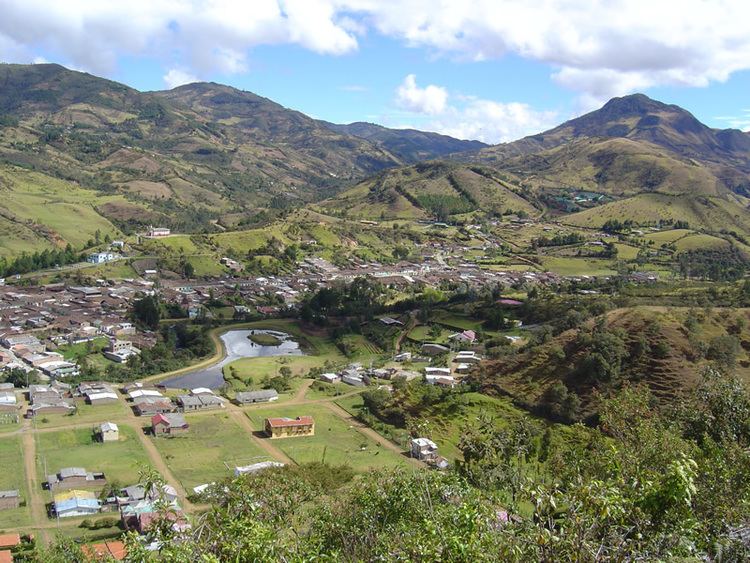Country Region Andean Region Founded June 15, 1857 | Area 29,308 km2 Capital Popayan | |
 | ||
Colleges and Universities University of Cauca, Colegio San Jose de Tarbes, University of the Pacific, Guapi Destinations Points of interest Tierradentro, Purace, Purace National Natural Park, Nevado del Huila, Dona Juana | ||
Governor Indigenous Social Alliance Movement | ||
Map of Cauca Department
Cauca ([ˈkawka]) is a Department of Colombia. Located in the south-western part of the country, facing the Pacific Ocean to the west, the Valle del Cauca Department to the north, Tolima Department to the northeast, Huila Department to the east and the Nariño Department to the south, Putumayo and Caqueta Departments are located and bordering the southeast portion of Cauca Department as well. covering a total area of 29,308 km², the 13th largest in Colombia. Its capital is the city of Popayán. The offshore island of Malpelo belongs to the department. It is located in the southwest of the country near the Andean (between 0°58′54″N and 3°19′04″N latitude, 75°47′36″W and 77°57′05″W longitude). The area includes 2.56% of the country.
Contents
- Map of Cauca Department
- Administrative Division
- Physiography
- Colombian Massif
- Hydrography
- Economy
- References
Administrative Division
Cauca department is divided into 38 municipalities, 99 districts, 474 police posts and numerous villages and populated places. The municipalities are grouped into 27 circles and 29 notaries notary, a circle-based registration in Popayán and eight sectional offices based in Bolívar, Caloto, Puerto Tejada, Santander de Quilichao, Patia, Guapi and Silvia, makes up the judicial district, Popayán, with 8 seats judicial circuit in Popayán, Bolívar, Caloto, Guapi, Patia, Puerto Tejada, Santander de Quilichao and Silvia. The department makes up the constituency of Cauca.
Physiography
The relief of the territory of the department of Cauca belongs to the Andean system at the macro level seven distinguishing morphological units: the Pacific plate, western cordillera, Central cordillera, highlands of Popayán, Macizo Colombiano, Valle del Patia and the sector of the Amazon basin. The Pacific plate comprises two sectors, the alluvial coastal belt or platform characterized by low, covered with mangrove forest, swampy, both the quantity of rivers, estuaries and reaching the Pacific coast, such as being subjected the ebb and flow of tides, the other area is the actual plain of hills comprising the western slopes of the western cordillera.
The western cordillera in the Cauca extends from southwest to northeast, among the most important accidents is the blade of Napí, the hills of Guaduas, Munchique and Naya and the Cauca River Valley. The central mountain range crosses from south to north of the department, relevant accidents are Sotará volcano, Petacas Nevado del Huila and in the departmental boundary.
The highlands of Popayán, sandwiched between the Western and Central Cordilleras, is seen as an accident within the plateau the hill La Tetilla. The Colombian Massif shared with the department of Huila, among the most representative accidents are the Páramo del buey, the volcanoes of Cutanga and Puracé, the peak of Paletará and the Sierra Nevada of Coconucos. Patia Valley, framed by the Central and Western mountain ranges, where the river runs north-south Patia, extends to the department of Nariño. The Amazon Basin, corresponds to the so-called Bota Caucana, through which the Caquetá river.
Colombian Massif
The Colombian Massif, also called the Nudo de Almaguer, is a mountainous group of "Andes colombianos" covering the departments of Cauca, Huila and Nariño in the south is the Nudo de los Pastos and emerge north central and eastern mountain ranges. The Colombian Massif is a strategic national and international level, given its significance for water production, biodiversity and ecosystems, an area that represents a special conformation of the regions with more potential for development in Colombia.
Hydrography
The Cauca river system, consists of five major basins: Alto Cauca, Pacific, Alto Magdalena, Patia and Caqueta.
Alto Cauca, formed by the Cauca River and its tributaries: Palo, Guengué, Negro, Teta, Desbaratado, and Quilichao, Mondomo, Ovejas, Pescador, Robles, Piedras, Sucio, Palacé, Cofre, Honda, Cajibío, Piendamó, Tunia, Molino, Timbío and Blanco.
The Pacific, made up mainly by rivers Guapi, Timbiquí, Saija and Micay.
Alto Magdalena, the main river is the Páez River which is fed by the rivers: San Vicente, Moras, Ullucos, Negro y Negro de Narvaez, and the streams: Toez, Símbola, Salado, Gualcar, Gallo, Macana, Honda and Totumo.
Patia basin, consists of the Patia River and its tributary rivers Guachinoco, Ismita, Bojoleo, El Guaba, Sambingo and Mayo.
Caquetá basin, consists of the Caquetá River where the rivers Cusiyaco, Cascabelito, Verdeyaco, Mandiyaco, Fragua, Cascabel, Curiaco and Pacayaco. Gorgonilla and Gorgona islands are located in the Pacific Ocean, belong to the territory Cauca.
Economy
The Cauca economy is based primarily on agriculture and livestock production, forestry, fishing and trade. Agriculture has been developed and modernized in the northern department, with main crops are sugar cane, cane panela, conventional maize, rice, corn tech, banana, agave, yucca, potatoes, coconut, sorghum, cocoa, groundnut and palm.
In the Pacific region is extracted gold, silver and platinum. Other non-precious minerals that are exploited are sulfur, asbestos, limestone, talc, gypsum and coal. The manufacturing industry is located in Popayán, Santander de Quilichao, Puerto Tejada with factories of food, beverages, dairy products, paper, packaging, wood processing, sugar industry and paper processing for export. The main centers of commercial activity are Popayán, Santander de Quilichao, Patia, Puerto Tejada, Piendamó and Corinto.
